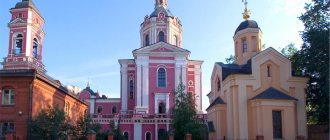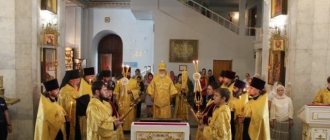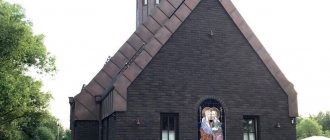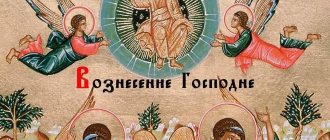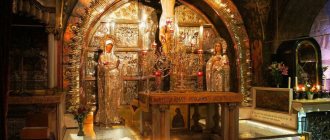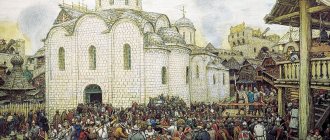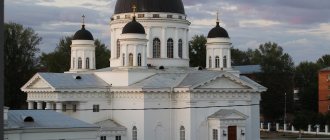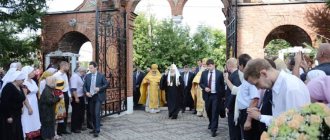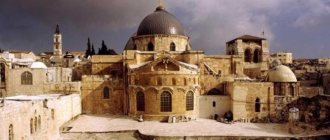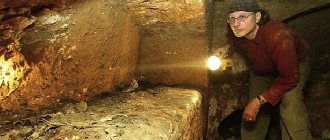Temple of the Great Ascension at the Nikitsky Gate in Storozhi . Before him, there was a small church on this site, which was first mentioned in the chronicles of 1619.
In 1685, instead of the old structure, the construction of a new one began - a stone one. Funds for construction were allocated by Natalya Naryshkina, the mother of Peter I.
Later, the Church of the Ascension of the Lord was rebuilt. The initiator was Prince Potemkin.
Since the building was conceived as a regimental cathedral, its dimensions had to be quite impressive.
The foundation of the old building turned out to be not quite strong for the construction of this kind of cathedral. Therefore, Potemkin gives his yard, which was nearby, for the future church. The prince died before construction began.
Bolshaya Nikitskaya - Church of the Ascension of the Lord (“Little Ascension”)
Address: Moscow, st. Bolshaya Nikitskaya, 18/1.
The Church in honor of the Ascension of the Lord on Bolshaya Nikitskaya Street in the White City is also called the “Small Ascension”. This began in the early thirties of the 19th century. There is also a “Great Ascension” in the capital - this is a temple outside the Nikitsky Gate.
Starting from the second half of the 14th century, the road to Veliky Novgorod through Volokolamsk passed next to the wooden temple. There is a version that the parish was born as the center of a settlement of Novgorod and Ustyug residents.
The stone church “in place of the ancient one” was erected by Tsar Fyodor Ioannovich - in honor of his coronation on the day of the Feast of the Ascension of the Lord Jesus Christ.
In 1548, a mention of the temple appears in the chronicle - Prince Pyotr Shuisky caught here, “in a posad in the courtyard near the Ascension, near a good bell tower behind Neglinnaya on Nikitskaya Street on November 11,” Prince Mikhail Glinsky, who was fleeing from Ivan the Terrible.
The Romanov boyars historically settled near the temple, from whose family came the mother of Theodore Ioannovich - Empress Anastasia Romanova, the first wife of Ivan the Terrible.
In 1871, the area next to the temple became musical - when the Moscow Conservatory stood on Bolshaya Nikitskaya Street, its workers became parishioners of the “Little Ascension”.
In the 1930s, the church was closed and rebuilt into a dormitory and workshops. Services were resumed only in June 1992.
Church of the Great Ascension at the Nikitsky Gate (“Great Ascension”)
Address: Moscow, Bolshaya st., 36.
The wooden church of the “Ascension of the Lord in Storozhi”, or, as it is also called, the “Great Ascension”, was first mentioned in chronicles in the 15th century.
In 1629 the church burned down. In 1685-1689, Tsarina Natalya Naryshkina, whose courtyard was next door, built the stone Ascension Church in its place.
In the 18th century, the site under the temple became the property of Prince Grigory Potemkin. According to legend, it was at the throne of the Church of the Ascension in 1774 that the secret wedding of the prince and Catherine the Great took place.
In 1831, the old church was dismantled, leaving only the bell tower. The building according to the new project was completed only in 1848. The parishioners of the “Great Ascension” were representatives of the intelligentsia, nobility and merchants who lived nearby. In 1863, the funeral service was held here for the founder of the Russian acting school, Mikhail Shchepkin, and in 1928, for the great actress Maria Ermolova.
In 1925, the last Divine Liturgy was celebrated in the Church of the Ascension by Patriarch Tikhon of Moscow and All Russia. The Soviet authorities closed the church in 1931 and destroyed the ancient bell tower in 1937.
Until 1987, the church building housed a container warehouse and a laboratory of the Research Institute named after. Krzhizhanovsky. In 1990, the building was restored and returned to the Russian Orthodox Church.
Russian Orthodox Church
Archpriest Vladimir Divakov is the head of the office of the Moscow Patriarchate, dean of churches in the Central District of Moscow, rector of the Church of the Ascension of the Lord at the Nikitsky Gate (Great Ascension). Almost his entire life was devoted to serving the Church. For his 45 years of priestly activity, Father Vladimir was awarded the orders of the Blessed Prince Daniel of Moscow, II degree, St. Sergius of Radonezh, II and III degrees, Equal-to-the-Apostles Prince Vladimir, II and III degrees, state orders of Friendship and Honor. Last November, Archpriest Vladimir Divakov, along with other clergy, became the laureate of the national award “Person of the Year - 2006” for his outstanding contribution to the spiritual revival of Russia.
— Father Vladimir, tell us about yourself, in what family were you raised? How did you come to priestly service?
— I was born in 1937 in Moscow into a secular family. Mom worked as a teacher in an elementary school, and dad was an officer. In the first months of the Great Patriotic War, he died near Vyazma. My mother and I raised my younger brother. She, like her parents, was a deeply religious person and from an early age she took us to church. I was baptized in the Church of the Holy Apostles Peter and Paul in Lefortovo. Since childhood, he helped and served there. And even then I decided for myself that I would become a clergyman, but I understood that this would not happen soon. I graduated from high school and three years of Electromechanical College. In 1957, he entered the Moscow Theological Seminary, then continued his studies at the Moscow Theological Academy, graduating with the rank of candidate of theology. He served in various Moscow churches. He became the rector of the Presnensky Church in honor of the Ascension of the Lord at the Nikitsky Gate (Great Ascension) in 1990. My younger brother is also a priest. Now he is the rector (cleric) of the Berlin Cathedral. The son also chose this path and teaches at the Moscow Theological Seminary.
—Are there many churches on Presnya?
— For me, as the rector of the temple, which is located in the Presnensky district, and as the dean of the churches of the Central District, Presnya is not some geographical name for Moscow, but the center of the religious life of the city. Fifteen years ago there were only three Orthodox churches in the area, and in all of Moscow there were 45. In the early 90s, the restoration of lost Orthodox shrines, which have always attracted believers, began. Their restoration was not easy; many temples were seriously destroyed. Now there are 238 churches in the Central District alone, 14 of which are in the Presnensky district. They filled the life of Presnya not only with spiritual content, but also became an architectural decoration of the area. I would not say that today all churches have been completely restored. The reconstruction of the Church of St. Nicholas on the Three Mountains, which was in a semi-destroyed state, took ten years. At first, the House of Culture of Pavlik Morozov was located there, then they intended to house the workshop of the Trekhgornaya Manufactory in the building. The room did not resemble a temple in any way. Another Presnensky church - St. John the Evangelist on Tverskoy Boulevard was generally in disrepair. In general, the shrines have been restored, but much remains to be done to completely recreate their interior decoration and return them to their former appearance.
— Tell us about the Great Ascension Church and its history.
— “Great Ascension” is the main temple of the area. A wooden temple on this site was first mentioned in 1619; in 1685-1689 it was replaced by a stone one. In the form in which the temple exists now, it was built in 1798-1816 (the refectory) and in 1827-1840 (the main part of the temple). The main temple was built according to the design of famous architects of that time O.I. Bove and F.M. Shestakov with the preservation of the bell tower of the stone church of the 17th century. In the 19th-20th centuries, the Great Ascension Church, which had excellent acoustics, became the parish of the Moscow intelligentsia. Many historical events are connected with it. A.S. got married here. Pushkin, funeral service for M.S. Shchepkina, M.N. Ermolov. In this church, His Holiness Patriarch Tikhon performed his last service. In 1931, the temple was closed, the bell tower was destroyed, the premises first housed a production workshop, then a concert hall. It seemed that the spiritual threads connecting the advanced and educated people of that time were interrupted. But when services resumed here on September 23, 1990, the Great Ascension Church again became the center of the spiritual life of the Moscow intelligentsia.
The restoration of the temple was not easy. Outwardly it looked favorable, but inside it was a terrible sight. Instead of floors, there were deep gaps, there were many unnecessary extensions and openings that had to be broken down, cleaned out and restored again. The Shchusev Museum preserves some photographs of the interior of the temple. And using them we restored it. They carried out very complex and expensive work - wood carving, gilding, painting icons, painting vaults. It’s interesting that when we started clearing the vaults, and we had to clear them with a scalpel, one decimeter at a time, we found the remains of the previous painting under 8-10 layers of paint. Now this painting is open. And we don’t regret at all that we put so much effort into restoring it. We had the opportunity to look up to something and continue working in the same style. The Prefecture of the Central District and the Presnensky District Administration provided significant assistance in improving the area around the temple, where a cozy square and fountain appeared. The district and district authorities also helped restore the bell tower, which, according to Moscow Mayor Yu.M. Luzhkov, became the dominant feature of the square and completed the architectural appearance of the temple.
—Are there many believers in the area? Who are your parishioners today? Are there any young people among them? Do famous people come to the temple?
— I think there are enough believers in churches. Although the city center is not as populated as the new areas. But on holidays, many people from remote areas come to us. Many intellectuals and famous people come to the temple - artists, scientists, politicians and other recognizable faces. They behave like ordinary laymen, do not stand out in any way, and do not emphasize their importance.
Young people also come. I would say that now the generation has changed. Previously, there were mainly grandmothers in churches. This generation is gone. At one time we were warned that the churches were filled with grandmothers, they would leave and no one would come. Temples will be empty. But this did not happen. Temples are still filled with people, including young people. They baptize their children, get married, take communion.
— Does it happen that non-believers, already in adulthood, still come to faith in God?
— There are many such examples. Recently a 60-year-old man came and asked to be baptized. He said that he worked on television, made reports on Orthodox topics, but he himself kept putting off baptism. There was such a case. On Easter, an elderly man, a war veteran with many awards, came to the church and asked to be baptized. They explain to him: he needs to wait, it’s Easter, but he says that he had a vision, and he needs to be baptized today. He was christened.
—Have such modern technical innovations as cell phones, computers, the Internet and others found their place in the Orthodox Church?
— Of course, cell phones have penetrated everywhere. The clergy also have them. Nobody forbids using them. The only thing is that during the service we ask parishioners to turn off their phones. Of course, computers and other modern technology are used. Without it, maintaining documentation is now unthinkable.
Now parishes have begun to use the Internet. A website is an effective way to convey information to those parishioners who are comfortable with it. They contain a schedule of services, announcements of parish events, news, stories about holidays, and pages for children. There are sections aimed at a wider audience. This includes publications by the clergy, the “Questions and Answers” columns, etc. The home church of the Holy Martyr Tatiana at Moscow State University. M.V. Lomonosov is a pioneer in this regard. Not long ago, the official portal of the Russian Orthodox Church was created. In Presnya, for example, the Church of St. Nicholas on Three Mountains in Novovagankovsky Lane has its own website. However, we should not forget that no technology can replace personal, live participation in church services.
— Does the Church consider computer games harmful to a child’s soul? What is the best thing for parents to pay attention to so that the computer brings more benefit and less harm to the child’s soul?
— It seems to me that the less time a child spends at the computer, the better. And the later children sit down at the computer, the more useful it is for them. This is still a virtual world, not a real one. In addition, the child needs to move, needs physical exercise, and just walk and breathe fresh air. If we raise children so that they spend time in the virtual world, wean themselves from working and thinking independently and creatively, then we will raise passive, unspiritual people.
—Currently, classes in Orthodox culture are being introduced in schools. What are they needed for?
— The origins of Russian culture lie in Orthodoxy. It was this that shaped the spirituality, history, and identity of our country. Russia has always been a multinational country. And people were tolerant of each other, of different religions. And this is also inherent in Orthodox culture. In many cities of Russia, the subject “Orthodox Culture” is studied with pleasure, even the children themselves talk about it, in Tatarstan or Mordovia. I know people of Jewish nationality who say: why don’t we study this subject if we live in Russia and want to know Russian culture and history. However, in Moscow there is some opposition to introducing this subject in city schools. There are people who, without delving into the essence of the matter, consider the lessons of Orthodox culture to be the law of God. But this is not the law of God, this is, first of all, the history and culture of our country. By the way, His Holiness the Patriarch devoted an entire chapter of his report to this topic at one of the Diocesan meetings. I think that all difficulties and contradictions will increasingly be overcome, and Orthodoxy lessons will appear in Moscow schools, even if on an optional basis.
— Father Vladimir, how do you feel about the project “We are writing together the history of Presnya”, within the framework of which, for example, a book on the history of the Presnensky district was published, many different events and meetings are held?
“I’m glad that the editors of your newspaper have such a noble goal.” You are engaged not only in informational, but also in spiritual education of the residents of the region and Muscovites in general. And the fact that you are trying to write the history of your “small homeland” is a good thing, especially for the younger generation. I would like to wish you continued success in this. So that your audience expands, because such topics attract people to your newspaper.
Temple of the Ascension in Kolomenskoye
Address: Moscow, Andropova Ave., 39, building 1.
The Church of the Ascension in Kolomenskoye is the first stone tented church in Moscow. It was built in 1529 - 1532 by order of Grand Duke Vasily III.
On March 15, 1917, the day of Emperor Nicholas II’s abdication from the throne, the miraculous “Sovereign” icon of the Mother of God was found in the Church of the Ascension. Now it is open for worship in the Kazan Church in Kolomenskoye.
The bell tower with the Church of the Great Martyr George the Victorious was built at the temple in the 16th century. There is a version that on the site of its construction stood a temple of an earlier construction - from the time of Demetrius Donskoy. The guess is partially confirmed by a discovery from the beginning of the 20th century - the remains of a cemetery from the 14th - 16th centuries were discovered here.
In the 17th century, a wooden refectory was added to the bell tower, and the bell tower itself was turned into the altar of the temple and consecrated. True, two centuries later, in 1843, the church and refectory were dismantled and rebuilt using decorative elements and proportions of the ancient building.
Since 2003, restoration of the bell tower and St. George's Church has been underway; they promise to restore the lost decor of the temple and iconostasis of the 19th century.
Architecture and sights of the church
The Church of the Ascension is a unique architectural masterpiece of the 16th century.
Did you know? It became not only the first tented stone church, but it is also considered to be the first tented church in Russia. It is believed that even wooden tented churches began to be built after the Kolomna Church.
The building is very beautiful. This elegant white stone temple rushes upward towards the light with its octagonal tent, the height of which reaches 41 meters.
The architecture of the church is richly decorated both outside and inside. Despite all the elegance and solemnity, the temple is quite small in size (its main hall is limited to 8.5 by 8.5 meters). This is explained by the fact that the church was built as a “home” church for the ruler’s family, and it did not need large sizes. In the architecture of the Church of the Ascension it is easy to notice many elements of the Italian Renaissance, which, in fact, became the reason for the assumption of the participation of Italian craftsmen in its construction. Nowadays you can admire not only the architectural, but also the cultural and historical sights of the church, as fascinating museum exhibitions are located within its walls. You will be able to see:
- Ancient tyablo iconostasis;
- The Royal Doors, which are an exact copy of the 16th century gates;
- Royal Doors of the 19th century;
- The exhibition “Secrets of the Church of the Ascension”, which is constantly running in the church basement.
Important! The palace village of Kolomenskoye near Moscow has an ancient and rich history, which is reflected in many of its buildings and monuments that have survived to this day. I highly recommend not limiting yourself to visiting the Church of the Ascension, but also visiting other valuable objects in Kolomenskoye.
Temple of the Ascension outside the Serpukhov Gate
Address: Moscow, Bolshaya Serpukhovskaya st., 24.
The stone Church of the Ascension of the Lord was erected on the site of an already existing one - a wooden one. This happened outside the Serpukhov Gate of the Zemlyanoy City in 1696 - 1709. Tsarevich Alexei Petrovich paid for the construction. In 1714, when the prince was executed, construction was frozen and finally completed only forty years later, however, in a different style - mature baroque.
In 1842, a refectory and a three-tier bell tower were added to the temple.
During the years of Soviet power, from 1930 to 1991, the church was closed. In the early 1990s, major restoration work was carried out in it - the bell tower, fence, and clergy house were updated. The temple was re-consecrated in 1991.
In 1995, an orphanage and the Synodal Department of the Moscow Patriarchate for interaction with the armed forces and law enforcement agencies began operating at the Ascension Church. The church community supports the Children's Clinical Hospital No. 1 and the Research Institute of Surgery of the Russian Academy of Medical Sciences. A. V. Vishnevsky.
Temple of the Ascension - Magnitogorsk
Address: Magnitogorsk, st. Voznesenskaya, 33.
The Church of the Ascension of the Lord is located in Magnitogorsk. It is located on the right bank of the Ural River. This is a young temple, it was built based on the cross-domed churches of Ancient Rus' of the 14th-15th centuries and opened to believers in 2004.
Next to the temple there is a source of holy water, and in the building next to it there are a Sunday school, a house of mercy with a house church, a refectory, a first-aid post and an almshouse, that is, in fact, a large social center.
Temple of the Ascension on the Pea Field
Address: Moscow, st. Radio, no. 2, p. 1.
The Church of the Ascension on the Pea Field was built in 1788 - 1793 on the lands of Count Alexei Razumovsky according to the design of the architect Matvey Kazakov
financed by parishioners and a major contribution from Nikolai Demidov.
During the years of Soviet power, the temple was closed. From 1935 to 1993, its building housed workshops, a printing house, then an exhibition hall and production workshops. Nevertheless, the church was restored during these years - from the 1960s until the 1990s.
In 1993, the Ascension Church was returned to the Russian Orthodox Church. Now a brotherhood has been opened under him in the name of Grand Duchess Elizabeth Feodorovna.
Ascension of the Lord: description and meaning
Orthodoxy testifies that on the third day after his voluntary death on the cross, Jesus Christ rose from the dead. This also became the work of the Lord’s atonement for the sins of mankind, its salvation from the power of evil and spiritual death. Over the next forty days, Christ remained on Earth among His disciples. This was necessary so that they would be convinced of His bodily resurrection and strengthened in their faith. The Savior gave them final instructions and informed them of the imminent descent of the Holy Spirit on them (Acts 1:2-9).
After 40 days, the Lord blessed the disciples on the Mount of Olives and ascended into heaven in the flesh. Immediately after this, two angels appeared and informed the apostles about the coming second coming of Christ (Acts 1:9-11).
The Ascension of the Lord became one of the main events of sacred New Testament history. It completed the earthly ministry of Christ, the era of His visible presence in our world. From that moment on, the Son of God was invisibly present in the Church through the influence of the Holy Spirit.
The Ascension also completed the Lord's salvation and deification of human nature. He ascended to the Heavenly Kingdom in His physical body. This means that not only the spiritual, but also the material nature of man has reached maximum closeness to God. Saint Demetrius of Rostov teaches:
“Before the Ascension of the Lord, none of the people had a path to Heaven... When our Lord, clothed in human nature, ascended to heaven, he immediately showed for the entire human race the path to heaven... Through them worthy and righteous people ascend, following in the footsteps of Christ” ( "Creations")
The Feast of the Ascension of the Lord is celebrated by the Church on the 40th day after Easter, Thursday. It is the twelfth, that is, one of the 12 main church holidays. Let's talk about the most famous churches of the Russian Orthodox Church, dedicated to the Ascension of Christ.
Temple of the Ascension in Elektrostal
Address: Elektrostal, st. Chernyshevsky, 34.
In the early 1990s, a community of believers was registered in Eletrostal. Two years later, the community was given the territory of the former Stroitel Cultural Center on Chernyshevsky Street.
Almost ten years after the creation of the community, believers had their first long-awaited baptismal church in the name of the holy righteous John of Kronstadt, the predecessor of the large Ascension Church.
The Ascension Church is still being completed. Since 2011, after a long break due to financial problems, construction work has resumed with renewed vigor. The whole world collects money for the church.
Features of visiting the Church of the Ascension
Did you know? Nowadays, the Church of the Ascension is both part of the Kolomna Museum-Reserve and the Patriarchal Metochion.
- Church activity here was restored in 1994, 2 years after which the church was included in the UNESCO World Heritage List.
- The museum exhibition is open from Tuesday to Sunday from 10:00 to 18:00, on Saturdays from 11:00 to 19:00. It is closed on Mondays.
- Tickets can be purchased at the museum box office from 10:00 to 17:30 (on Saturday from 11:00 to 18:30), as well as on the Kolomna Museum website.
